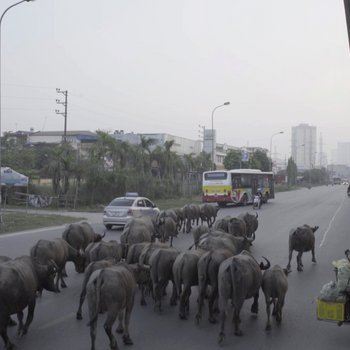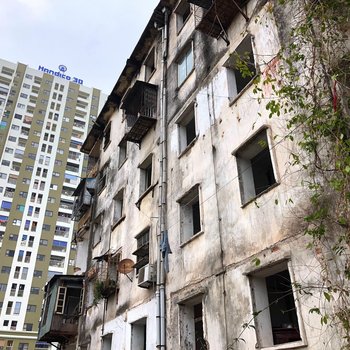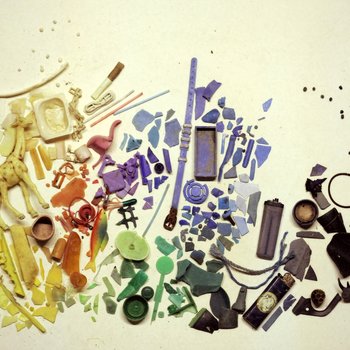Seventeen works from the artist’s oeuvre – which originally comprised around 150 paintings – were examined in the research project “Oskar Zwintscher (1870–1916). The Unknown Masterpiece” by the Staatliche Kunstsammlungen Dresden in the Albertinum, funded by the Friede Springer Stiftung, subjecting them to art technology analysis in the painting restoration workshop.
After an initial inspection, the surface was examined under a stereomicroscope and analysed using various methods. The artist's complex working method demanded an intensive comparative evaluation of all findings, which are listed for each painting in the Albertinum’s 2021 catalogue.
It is clear that Oskar Zwintscher did not use a single method of painting and that each of the examined works instead exhibits its own peculiarities that produce an unexpected variety and complexity. This raises the question of how his working method can be classified in the transitional phase to modernism, a period characterised by enthusiastic experimentation with painting techniques and countless developments.
For a better understanding, it is important to note first of all that the research revealed a very dynamic painting process in some of the works. For example, Oskar Zwintscher changed the format of four pieces during the painting process by reducing the size of the canvas and adapting the depiction to suit his new idea. Quite apart from the underdrawing, he repeatedly applied intermediate sketches to the layers of paint that are barely distinguishable using the examination methods.
In Zwintscher's work, painting and frame are directly related. However, different procedures are recognisable here. Three works were already framed during the painting process. In the covered areas below the frame rebate, the layers of paint that were applied first are visible. On two paintings Zwintscher applied the final glaze after framing. Remnants of this glaze can be found on the frames. In four paintings the layer of paint had not yet dried completely at the time of framing, so that the fold is pressed into the surface. These works were exhibited soon after their completion and were probably framed quickly for this reason.
Silke Beisiegel
(Excerpt from the catalogue Weltflucht und Moderne. Oskar Zwintscher in der Kunst um 1900, Albertinum, Staatliche Kunstsammlungen Dresden, Dresden 2022, p. 190 et seq.)
The following uses X-radiographs to retrace various aspects of the painting process, which provides insight into the literal complexity found in the structure of Oskar Zwintscher’s paintings.
The Artist’s Wife as a Young Girl, 1894
This painting is the earliest verifiable portrait of Oskar Zwintscher’s later wife Adele. The X-radiograph shows, among other things, the first, somewhat smaller version of the head as well as the reworking of a background that was originally created differently using impasto paint and a painting knife. Changes in the hairstyle (topknot) are also plainly visible.
Portrait of the Artist’s Wife, 1902
The approximately life-size portrait depicts Adele Zwintscher aged 30. The X-radiograph reveals a figure turned initially to the right, with her right arm extended outwards in front of her body. There was probably a view of a landscape on the right of the background. A door lock can be seen in the centre-left of the picture, which was later painted over.
Self-portrait, 1904
The artist’s half-length depiction originally showed a more expansive posture of the left arm. The contour of the right arm was revised several times. Zwintscher later painted over the round cup tiles shown in the background on the right with a shell-shaped ornament in the style of Art Nouveau.
Fruit Blessings, 1913
Zwintscher had superimposed the painting of a late summer landscape on an already well advanced first version of the picture. On the hill rising first on the right was a large house with a ridge turret. A roof terrace with a slatted floor, wooden railings with wide filler boards and corner posts was depicted in the lower half of the painting.
Portrait of the Artist’s Wife by the Sea, 1912
The background with a wide, flat coastal landscape and rock wall was completely different in the first version of the portrait: the view from a narrow balcony showed a garden landscape. The sitter’s figure remained unchanged except for a clear turn of the head.
Encounter, 1915
While the two figures remained basically unchanged (except for the overpainting of the woman’s right ear and other details), the background underwent a very significant transformation: beneath the seascape, the X-radiograph reveals a rocky environment, with a bubbling stream between woman and man.
Grief, 1898
Initially in landscape format, the scene was enlarged by adding to the canvas at the upper edge of the picture. The X-radiograph reveals the first, smaller representation of the personification of death, with a lower hump and narrower hands. The boulder was also enlarged along with the format.
Lord Mayor Dr Beutler, 1910
Zwintscher had been working on the portrait of Otto Beutler for some time. Multiple changes in the wallpaper pattern in the background (which are even more evident in the infrared reflectogram), as well as alterations to the positions of the hands, are indicative of how the composition was adapted during the painting process: the right hand originally rested on the sitter’s right leg, his left on the knob of the left armrest.
Page [Adele Zwintscher in a page boy’s uniform], 1913
The X-radiograph reveals a first version of Adele Zwintscher in a seated position turned to the left beneath the currently visible depiction of her standing up. While the right arm was raised and placed on an unidentifiable object, the left arm rested in the figure’s lap. A vertical stripe at the right edge of the picture suggests the presence of a curtain.
Between Jewellery and Song, 1910
The X-radiograph of this painting shows comparably few changes in design. Only the central female figure initially had a wider pelvis and the face was turned more to the left. There are also visible differences in the woman’s hairstyle. The feet of the naked male figure on the right were finished completely before the sandals were painted on.
A cooperation with the Dresden Academy of Fine Arts
Investigations, recordings and evaluations by Silke Beisiegel, Monika Kammer, Wolfgang Kreische, Ivo Mohrmann, and Kerstin Riße
Exhibition Escapism and Modernity. Oskar Zwintscher in Art around 1900
Curated by Andreas Dehmer, Birgit Dalbajewa
Sponsored by the Sparkassen-Finanzgruppe and the Ernst von Siemens Kunststiftung
Albertinum Dresden, 14. 5. 2022 – 15. 1. 2023
A cooperation with the Museum Wiesbaden (3. 3. 2023 – 27. 7. 2023)
Image texts by Andreas Dehmer and Monika Kammer
Also of interest:
Arlette Quynh-Anh Tran curated the first of our film series for the Kontrapunkte project, which deals with the cultural interweavings of the GDR and Vietnam. In conversation with Kathleen Reinhardt from the Albertinum, she explains the questions that preoccupied her in the process.

The annihilation of Vinh City by US bomb raids offered an opportunity for experimental planning and for transforming the small industrial town into a model socialist city. The GDR’s ambitious task of comprehensive reconstruction involved working collectively on both the creation of a master plan and its realization in built form. Christina Schwenkel on the Quang Trung housing complex.

What remains of us? Currently quite a lot. In her film collage "Die Hüter des Unrats - eine kurze Geschichte des Abfalls" (The Guardians of Garbage - A Short History of Waste), which can currently be seen at the Japanisches Palais, Susann Maria Hempel takes a sarcastic look at the way we deal with waste and its ecological consequences. About the stomachs of predatory fish, chickens and giant tortoises as an archive.
